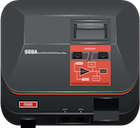
Welcome to our page dedicated to Sega Master System reverse engineering! The Sega Master System was a popular gaming console released by Sega in 1985, and has since become a beloved classic of the gaming world. If you’re interested in learning more about the technical aspects of this console and how it works, you’ve come to the right place.
On this page, we’ve compiled a list of links to other pages that cover various topics related to Sega Master System reverse engineering. Whether you’re interested in understanding the hardware architecture of the console, analyzing game code, or exploring the many mods and hacks that have been created by enthusiasts over the years, you’ll find a wealth of resources and information on the pages we’ve linked to.
So grab your Sega controller, and get ready to dive into the exciting world of Sega Master System reverse engineering!
One of the best ways to find out what it was like developing games for the SEGA Master System is to look at old developer interviews from Games Magazines published in the 90s.
SMS Power has re-posted an interview from Zero magazine issue 7 where they interview the game developers at US Gold on developing the games Impossible Mission and Gauntlet.
Apparently Impossible Mission for the Sega Master System will be on a 128K cartridge which is comprised of:
For development hardware they used an ordinary PC with Z80 assembler connected to a Sega Master System via a Z80 Probe which plugs into the CPU slot on the motherboard (instead of the CPU). It also mentions that they use RAM to hold the game data instead of a ROM Chip, so presumably there is some interface between the PC and the RAM chip to be able to write the game data to it. It mentions that this is fast but as as fast as PDS which is another Master System development kit.
In this same interview they comment on Japanese Sega Game developers:
The often dubious quality of some of the Sega games is down to the strange programming habits of the Japanese. Generally there are around six people working on a game for a year. It’s the way developers recruit programmers that is bizarre; they put an ad in the local rag asking for anyone interested in computing to contact them. The developers then train the new recruits and get them to join a team of novices to start work on a game. Established programmers aren’t even considered.
It is a rather odd statement to make, almost sounds like one of the developers was salty about not being recruited for a Japanese Game developer…
You can read the full interview here:
One of the best interviews with Sega Master System Developers was in the UK Magazine called S the Sega Magazine, specifically issue 8 where they interview the programmers of MirrorSoft in Bath about their upcoming game Speedball.
You can read the full interview here: S the Sega Magazine - Issue 8 - Back to the Future - Articles - SMS Power
The Sega Master System has multiple hardware revisions in its life time along with many different development kits as SEGA themselves didn’t produce an official one for developers to use.
Introduction to Development Kits (Hardware)
For more information on Master System Development Hardware check out this post.
The Sega Digitizer System was a development kit specifically for creating sprites and background tiles officially inside SEGA. It is unclear if they ever sold the system to third party developers.
This was not exclusive to Sega Master System development, it was also used in early sega arcade games, system 1 and system 16 (1986) and all the way up to Mega Drive (it had 3 different versions).
You can find out more including lots of images on Video Games Densetsu: The Sega Digitizer System, a tool used by graphic…
The main components of the retail Sega Master System are:
For an in-depth look at the SMS Retail hardware architecture check out the excellent post by Copetti.org:
Sega Master System (SMS) Architecture - A Practical Analysis
Copetti.org has an excellent tear down of the SMS Hardware and how it works
The Z80 processor was a common choice for many home computers and gaming consoles during the early 1980s. It provided the computational power necessary to run a variety of games and applications on the Sega Master System. The Z80’s architecture made it a versatile and widely used processor at the time, allowing developers to create games and software for the console.
The Z80 Microprocessor - Pioneering Gaming and Beyond
For more information about the Z80 CPU used in the Sega Master System check out this post.
Officially SEGA didn’t provide much to game developers and expected them to create their own development toolchain, however they did provide the following documentation:
It would be up to the game developers to find their own Z80 Assembler and Linker and write any common library routines for drawing graphics or reading input.